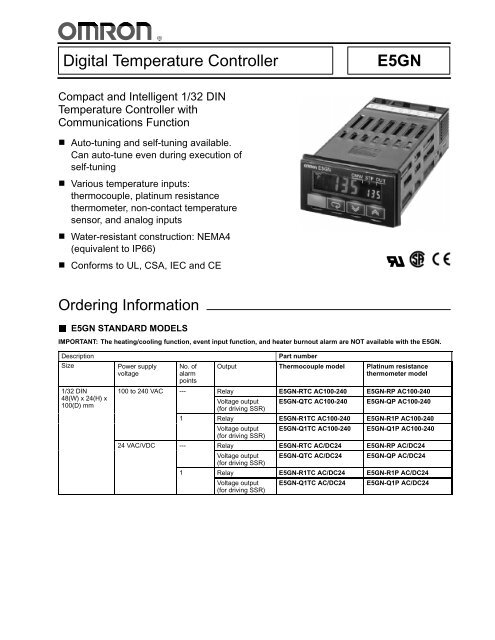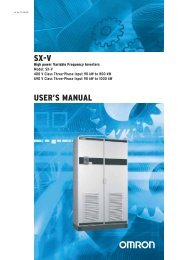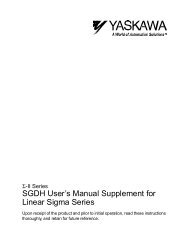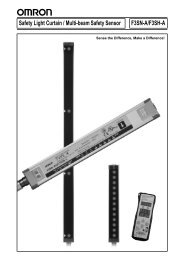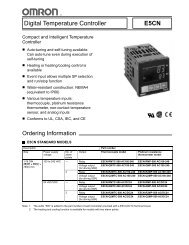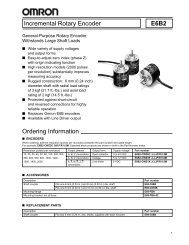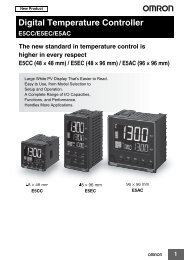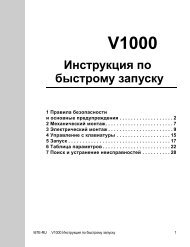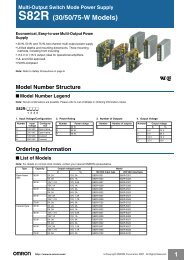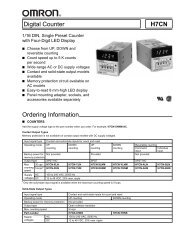Digital Temperature Controller E5GN
Digital Temperature Controller E5GN
Digital Temperature Controller E5GN
You also want an ePaper? Increase the reach of your titles
YUMPU automatically turns print PDFs into web optimized ePapers that Google loves.
<strong>Digital</strong> <strong>Temperature</strong> <strong>Controller</strong><br />
<strong>E5GN</strong><br />
Compact and Intelligent 1/32 DIN<br />
<strong>Temperature</strong> <strong>Controller</strong> with<br />
Communications Function<br />
Auto-tuning and self-tuning available.<br />
Can auto-tune even during execution of<br />
self-tuning<br />
Various temperature inputs:<br />
thermocouple, platinum resistance<br />
thermometer, non-contact temperature<br />
sensor, and analog inputs<br />
Water-resistant construction: NEMA4<br />
(equivalent to IP66)<br />
Conforms to UL, CSA, IEC and CE<br />
<br />
Ordering Information<br />
<strong>E5GN</strong> STANDARD MODELS<br />
IMPORTANT: The heating/cooling function, event input function, and heater burnout alarm are NOT available with the <strong>E5GN</strong>.<br />
Description<br />
Size<br />
1/32 DIN<br />
48(W) x 24(H) x<br />
100(D) mm<br />
Power supply<br />
voltage<br />
No. of<br />
alarm<br />
points<br />
Part number<br />
Output Thermocouple model Platinum resistance<br />
thermometer model<br />
100 to 240 VAC --- Relay <strong>E5GN</strong>-RTC AC100-240 <strong>E5GN</strong>-RP AC100-240<br />
Voltage output <strong>E5GN</strong>-QTC AC100-240 <strong>E5GN</strong>-QP AC100-240<br />
(for driving SSR)<br />
1 Relay <strong>E5GN</strong>-R1TC AC100-240 <strong>E5GN</strong>-R1P AC100-240<br />
Voltage output <strong>E5GN</strong>-Q1TC AC100-240 <strong>E5GN</strong>-Q1P AC100-240<br />
(for driving SSR)<br />
24 VAC/VDC --- Relay <strong>E5GN</strong>-RTC AC/DC24 <strong>E5GN</strong>-RP AC/DC24<br />
Voltage output <strong>E5GN</strong>-QTC AC/DC24 <strong>E5GN</strong>-QP AC/DC24<br />
(for driving SSR)<br />
1 Relay <strong>E5GN</strong>-R1TC AC/DC24 <strong>E5GN</strong>-R1P AC/DC24<br />
Voltage output <strong>E5GN</strong>-Q1TC AC/DC24 <strong>E5GN</strong>-Q1P AC/DC24<br />
(for driving SSR)
<strong>E5GN</strong><br />
<strong>E5GN</strong><br />
<strong>E5GN</strong> COMMUNICATION MODELS<br />
IMPORTANT: The alarm function is NOT available with the communications models.<br />
Description<br />
Size<br />
1/32 DIN<br />
48(W) x<br />
24(H) x<br />
100(D) mm<br />
Power<br />
supply<br />
voltage<br />
100 to 240<br />
VAC<br />
Communication<br />
function<br />
Part number<br />
Output Thermocouple model Platinum resistance thermometer<br />
model<br />
RS-485 Relay <strong>E5GN</strong>-R03TC-FLK AC100-240 <strong>E5GN</strong>-R03P-FLK AC100-240<br />
Voltage <strong>E5GN</strong>-Q03TC-FLK AC100-240 <strong>E5GN</strong>-Q03P-FLK AC100-240<br />
output (for<br />
driving<br />
SSR)<br />
24 VAC/VDC Relay <strong>E5GN</strong>-R03TC-FLK AC/DC24 <strong>E5GN</strong>-R03P-FLK AC/DC24<br />
Voltage <strong>E5GN</strong>-Q03TC-FLK AC/DC24 <strong>E5GN</strong>-Q03P-FLK AC/DC24<br />
output (for<br />
driving<br />
SSR)
<strong>E5GN</strong><br />
<strong>E5GN</strong><br />
INPUT RANGES<br />
Platinum Resistance Thermometer Input/Thermocouple Input<br />
Shaded ranges indicate default settings.<br />
Platinum resistance thermometer input<br />
Input type<br />
Platinum resistance thermometer<br />
<strong>Temperature</strong> range<br />
Name<br />
Pt100<br />
JPt100<br />
1800<br />
1700<br />
1600<br />
1500<br />
1400<br />
1300<br />
1200<br />
1100<br />
1000<br />
900<br />
850<br />
800<br />
700<br />
600<br />
500<br />
400<br />
300<br />
200<br />
500.0<br />
500.0<br />
100<br />
0<br />
--100<br />
--200<br />
100.0<br />
0.0<br />
100.0<br />
0.0<br />
--200 --199.9<br />
--199.9<br />
Set value 0 1 2 3 4<br />
Thermocouple Input<br />
Shaded ranges indicate default settings.<br />
<strong>Temperature</strong> range<br />
Input type<br />
1800<br />
1700<br />
1600<br />
1500<br />
1400<br />
1300<br />
1200<br />
1100<br />
1000<br />
900<br />
800<br />
700<br />
600<br />
500<br />
400<br />
300<br />
200<br />
100<br />
0<br />
--100<br />
--200<br />
Thermocouple<br />
Thermocouple input<br />
Name K J T E L U N R S B<br />
1300<br />
--200<br />
500.0<br />
--20.0<br />
850<br />
--100<br />
400.0<br />
--20.0<br />
400<br />
--200<br />
600<br />
0<br />
850<br />
--100<br />
400<br />
--200<br />
1300<br />
--200<br />
ES1A Non-contact<br />
<strong>Temperature</strong> Sensor<br />
K10 to K60 to K115 to K160 to<br />
70°C 120°C 165°C 260°C<br />
Analog input<br />
0to50mV<br />
Usable in the following<br />
ranges by scaling:<br />
--19999 to 9999 or<br />
--199.9 to 999.9<br />
Set value 0 1 2 3 4 5 6 7 8 9 10 11 12 13 14 15 16<br />
1700<br />
0<br />
1700<br />
0<br />
1800<br />
100<br />
70<br />
0<br />
120<br />
0<br />
165<br />
0<br />
260<br />
0<br />
Applicable standards by input type are as follows:<br />
K, J, T, E, N, R, S, B: JIS C1602-1995<br />
L: Fe-CuNi, DIN 43710-1985<br />
U: Cu-CuNi, DIN 43710-1985<br />
JPt100: JIS C1604-1989, JIS C1606-1989<br />
Pt100: JIS C1604-1997, IEC751<br />
Note:<br />
The ES1A Non-contact <strong>Temperature</strong> Sensor will be available soon.
<strong>E5GN</strong><br />
<strong>E5GN</strong><br />
Specifications<br />
RATINGS<br />
Supply voltage 100 to 240 VAC, 50/60 Hz 24 VAC, 50/60 Hz/24 VDC<br />
Operating voltage range<br />
85% to 110% of rated supply voltage<br />
Power consumption 7VA 4VA/2.5W<br />
Sensor input<br />
Thermocouple: K, J, T, E, L, U, N, R, S, B<br />
Platinum resistance thermometer: Pt100, JPt100<br />
Non-contact temperature sensor: K10 to 70C, K60 to 120C, K115 to 165C, K160 to 260C<br />
Voltage input: 0 to 50 mV<br />
Control output Relay output SPST-NO, 250 VAC, 2 A (resistive load), electrical life: 100,000 operations<br />
Voltage output 12 VDC (PNP), max. load current: 21 mA, with short-circuit protection<br />
Alarm output<br />
SPST-NO, 250 VAC, 1 A (resistive load), electrical life: 100,000 operations<br />
Control method<br />
PID or ON/OFF control<br />
Setting method<br />
<strong>Digital</strong> setting using front panel keys<br />
Indication method<br />
7-segment digital display and single-lighting indicator<br />
Other functions<br />
According to controller model<br />
Ambient temperature<br />
-10C to55C (14F to 131F) with no condensation or icing<br />
Ambient humidity<br />
Storage temperature<br />
25% to 85% relative humidity<br />
-25C to65C (-13F to 149F) with no condensation or icing<br />
CHARACTERISTICS<br />
Indication accuracy<br />
Hysteresis<br />
Proportional band (P)<br />
Thermocouple:<br />
(0.5% of indicated value or 1C, whichever greater) 1 digit max. (See Note.)<br />
Platinum resistance thermometer:<br />
(0.5% of indicated value or 1C, whichever greater) 1 digit max.<br />
Analog input: 0.5% FS1 digit max.<br />
CT input: 5% FS1 digit max.<br />
0.1 to 999.9 EU (in units of 0.1 EU)<br />
0.1 to 999.9 EU (in units of 0.1 EU)<br />
Integral time (I) 0 to 3999 s (in units of 1 s)<br />
Derivative time (D) 0 to 3999 s (in units of 1 s)<br />
Control period<br />
1to99s(inunitsof1s)<br />
Manual reset value 0.0% to 100.0% (in units of 0.1%)<br />
Alarm setting range<br />
Sampling period<br />
Insulation resistance<br />
Dielectric strength<br />
Vibration resistance<br />
-1999 to 9999 (decimal point position depends on input type)<br />
500 ms<br />
20 MΩ min. (at 500 VDC)<br />
2000 VAC, 50 or 60 Hz for 1 min (between different charging terminals)<br />
10 to 55 Hz, 10 m/s 2 for 2 hours each in X, Y and Z directions<br />
Shock resistance 300 m/s 2 , 3 times each in 3 axes, 6 directions (relay: 100 m/s 2 )<br />
Note:<br />
The indication of K thermocouples in the -200°C to 1300°C range, and T and N thermocouples at a temperature of -100°C or less,<br />
and U and L thermocouples at any temperature is ±2°C±1 digit maximum. The indication of B thermocouples at a temperature of<br />
400°C or less is unrestricted.<br />
The indication of R and S thermocouples at a temperature of 200°C orlessis±3°C±1 digit maximum.<br />
(This table continues on the next page.)
<strong>E5GN</strong><br />
<strong>E5GN</strong><br />
Characteristics Table -- continued from previous page<br />
Weight Approx. 90 g Mounting bracket: approx. 10g<br />
Protective structure Front Panel NEMA4 for indoor use (equivalent to IP66)<br />
Rear Case IP20<br />
Terminals IP00<br />
Memory protection EEPROM (non-volatile memory) (number of writes: 100,000)<br />
EMC Emission Enclosure: EN55011 Group 1 class A<br />
Emission AC Mains:<br />
EN55011 Group 1 class A<br />
Immunity ESD: EN61000-4-2: 4 kV contact discharge (level 2)<br />
8 kV air discharge (level 3)<br />
Immunity RF-interference: ENV50140: 10 V/m (amplitude modulated,<br />
80MHzto1GHz)(level3)<br />
10 V/m (pulse modulated, 900 MHz)<br />
Immunity Conducted Disturbance: ENV50141: 10 V (0.15 to 80 MHz) (level 3)<br />
Immunity Burst: EN61000-4-4: 2 kV power-line (level 3)<br />
2 kV I/O signal-line (level 4)<br />
Approval standards<br />
UL3121-1, CSA22.2 No. 14, E.B.1402C<br />
Conforms to EN50081-2, EN50082-2, EN61010-1 (IEC1010-1)<br />
Conforms to VDE0106/part 100 (Finger Protection), when the terminal cover is mounted.<br />
COMMUNICATIONS SPECIFICATIONS<br />
Transmission path connection<br />
Communications method<br />
Synchronization method<br />
Baud rate<br />
Transmission code<br />
Data bit length<br />
Stop bit length<br />
Error detection<br />
Flow control<br />
Interface<br />
Retry function<br />
Communications buffer<br />
Multiple points<br />
RS-485 (two-wire, half duplex)<br />
Start-stop synchronization<br />
1,200/2,400/4,800/9,600/19,200 bps<br />
ASCII<br />
7or8bits<br />
1or2bits<br />
Vertical parity (none, even, odd)<br />
Frame check sequence (FCS): with SYSMAC WAY<br />
Block check character (BCC): with CompoWay/F<br />
Not available<br />
RS-485<br />
Not available<br />
40 bytes<br />
Note:<br />
The baud rate, data bit length, stop bit length, or vertical parity can be individually set using the communications setting level.
<strong>E5GN</strong><br />
<strong>E5GN</strong><br />
Nomenclature<br />
<strong>E5GN</strong><br />
Operation Indicators<br />
1. AL (alarm)<br />
Lights when alarm output is<br />
ON.<br />
2. CMW (communications<br />
writing control)<br />
Lights when communications<br />
writing is enabled and<br />
is out when it is disabled.<br />
3. STP (stop)<br />
Lights when control of the<br />
<strong>E5GN</strong> has been stopped.<br />
During control, this indicator<br />
lights when an event or the<br />
run/stop function has been<br />
stopped, or, this indicator is<br />
out.<br />
4. OUT (control output)<br />
Lights when control output<br />
is ON.<br />
<strong>Temperature</strong> Unit<br />
The temperature unit is displayed<br />
when the display unit parameter is<br />
set to a temperature. Indication is<br />
determined by the currently<br />
selected “temperature unit” parameter<br />
set value. When this parameter is set<br />
to “°C,” “” is displayed, and when set<br />
to “°F,” “” is displayed.<br />
No. 1 Display<br />
Displays the process value or<br />
parameter type.<br />
No. 2 Display<br />
Displays the set point, manipulated<br />
variable or set value (setup)<br />
of the parameter.<br />
Up Key<br />
Each press of this key increases<br />
values displayed on the No.2<br />
display. Holding down this key<br />
continuously increases values.<br />
Level Key<br />
Press this key to select the setup<br />
level. The setup level is selected<br />
in this order: “operation level” ←→<br />
“adjustment level,” “initial setting<br />
level” ←→ “communications<br />
setting level.”<br />
Mode Key<br />
Down Key<br />
Each press of this key decreases<br />
values displayed on the No.2<br />
display. Holding down this key<br />
continuously decreases values.<br />
Level + Mode Key<br />
This key combination sets the<br />
<strong>E5GN</strong> to the “protect level.”<br />
Press this key to select parameters<br />
within each level.
<strong>E5GN</strong><br />
<strong>E5GN</strong><br />
Dimensions<br />
Unit: mm (inch)<br />
<strong>E5GN</strong><br />
48<br />
(1.89)<br />
3<br />
100<br />
(3.94)<br />
35<br />
(1.38)<br />
24<br />
36.8<br />
(1.45)<br />
22<br />
(0.87)<br />
44.8<br />
(1.76)<br />
22<br />
(0.87)<br />
* When carrying out maintenance on the <strong>E5GN</strong>, only the terminal plate can be drawn<br />
out with the terminal leads still attached.<br />
Panel Cutout<br />
Mounted Separately<br />
60 min.<br />
Group Mounted<br />
(48number of units -2.5)<br />
+1.0<br />
0<br />
22 +0.3<br />
0<br />
60 min.<br />
Mounting separately does not allow waterproofing.<br />
45<br />
+0.6<br />
0<br />
22 +0.3<br />
0<br />
• Insert the <strong>Controller</strong> through the hole in the panel from the front and push the adapter on<br />
from the rear. Push the adapter up to the back of the panel, ensuring that the controller<br />
is pushed all the way in, and remove any gap between the <strong>Controller</strong>, the panel, and the<br />
adapter. Finally, use the two screws on the adapter to secure the unit in place.<br />
• To mount the <strong>E5GN</strong> so that it is waterproof, insert the waterproof seal onto the <strong>E5GN</strong>.<br />
• When two or more <strong>E5GN</strong> <strong>Controller</strong>s are mounted, make sure that the surrounding<br />
temperature does not exceed the allowable operating temperature given in the<br />
specifications.
<strong>E5GN</strong><br />
<strong>E5GN</strong><br />
Installation<br />
MOUNTING<br />
1. Insert the <strong>E5GN</strong> into the mounting hole in the panel from the<br />
front.<br />
2. Push the adapter along the <strong>E5GN</strong> body from the terminals up<br />
to the panel, and secure it temporarily.<br />
3. Tighten the two fixing screws on the adapter. When tightening<br />
screws, tighten the two screws alternately (keeping the<br />
torque to within approximately 0.29 to 0.39 Nm).<br />
Adapter<br />
Waterproof seal<br />
WIRING TERMINALS<br />
The voltage output (control output) is not electrically insulated<br />
from the internal circuits. When using a grounding thermocouple,<br />
do not connect the control output terminals to the ground. If the<br />
control output terminals are connected to the ground, errors will<br />
occur in the measured temperature values, as a result of leakage<br />
current.<br />
Standard insulation is applied to the power supply I/O sections. If<br />
reinforced insulation is required, connect the input and output<br />
terminals to a device without any exposed current-carrying parts<br />
or to a device with standard insulation suitable for the maximum<br />
operating voltage of the power supply I/O section.<br />
Panel<br />
Relay output<br />
Alarm output<br />
Voltage output<br />
Communications<br />
specification<br />
REMOVING AND ATTACHING THE<br />
TERMINAL PLATE<br />
Input power supply<br />
RS-<br />
485<br />
Host<br />
computer<br />
The <strong>E5GN</strong> can be replaced by removing the terminal plate.<br />
1. Press down hard on the fasteners on both sides of the terminals<br />
to unlock the terminal plate and pull upward.<br />
Two input power supplies are available:<br />
100 to 240 VAC or 24 VAC/VDC (no polarity).<br />
WIRING PRECAUTIONS<br />
<strong>E5GN</strong><br />
• Connect the terminals as specified below.<br />
Analog input<br />
Terminal No. Cables Pin terminals<br />
1to6 AWG24toAWG14 2.1 dia. max.<br />
7to9 AWG28toAWG22 1.3 dia. max.<br />
2. Pull to remove the terminal plate.<br />
• The exposed current-carrying part to be inserted into terminals<br />
must be 5 to 6 mm.<br />
5--6mm<br />
5--6mm<br />
Electrical wire<br />
Pin terminal<br />
3. Before you insert the terminal plate again, make sure that the<br />
pins match the positions of the holes in the terminal plate.<br />
• Tighten the terminal screws to the torque specified below.<br />
Terminal No. Screw Maximum tightening torque<br />
1to6 M2.6 0.24 Nm (2.5 kgfcm)<br />
7to9 M2 0.13 Nm (1.4 kgfcm)
<strong>E5GN</strong><br />
<strong>E5GN</strong><br />
Operation<br />
INITIAL SETUP<br />
On previous <strong>Controller</strong>s, sensor input type, alarm type and<br />
control period were set on DIP switches. These hardware<br />
settings are now set in parameters in setup menus. The and<br />
keys are used to switch between setup menus, and the<br />
amount of time that you hold the keys down determines which<br />
setup menu you move to. This section describes two typical<br />
examples.<br />
Note: On the <strong>E5GN</strong>, the Keyisthe Key.<br />
1. ON/OFF Control<br />
Typical Application Examples<br />
Typical Example<br />
Input type: 0 K thermocouple -200 to 1300°C<br />
Control method: ON/OFF control<br />
Alarm type: 2 upper limit<br />
Alarm value 1: 20°C (For setting deviation)<br />
Set point: 100°C<br />
Change only the alarm value 1 and set point.<br />
The rest must be left as default settings.<br />
• Changing Parameters<br />
Setup procedure<br />
Power ON<br />
Operation level<br />
Power ON<br />
Process value/<br />
set point<br />
Initial setting level<br />
Press key for at least<br />
three seconds.<br />
Control stops.<br />
indicates that there is a parameter.<br />
Keep on pressing the mode key until<br />
the desired parameter is selected.<br />
Set input<br />
specifications<br />
Set control<br />
specifications<br />
Check input<br />
type.<br />
Check that control<br />
is ON/OFF<br />
control.<br />
Input type<br />
In ON/OFF<br />
control <br />
• Changing Set Values<br />
Set alarm type<br />
Check alarm<br />
type.<br />
Alarm 1<br />
type <br />
Use the or keys to<br />
change the set value displayed<br />
in the setup menu.<br />
Display<br />
E5CN<br />
No. 1 display<br />
<strong>E5GN</strong><br />
No. 1 display<br />
Press key for at<br />
least one second.<br />
Operation level<br />
No. 2 display<br />
No. 2 display<br />
Set the set point<br />
Press keys<br />
to set set point to<br />
“100C.”<br />
Process value/<br />
set point <br />
Check operation<br />
state<br />
Set alarm values<br />
Make sure that<br />
control is running.<br />
Press keys<br />
to set alarm value<br />
to “20C.”<br />
During run<br />
<br />
During stop<br />
Alarm<br />
value 1<br />
Start operation<br />
Start operation
<strong>E5GN</strong><br />
<strong>E5GN</strong><br />
2. PID Control Using Auto-tuning<br />
Typical Example<br />
• Changing Parameters<br />
Input type: 4 T thermocouple -200 to 400°C<br />
Control method: PID control<br />
ST (self-tuning): OFF<br />
Calculate PID constants by AT (auto-tuning).<br />
Alarm type: 2 upper limit<br />
Alarm value 1: 30°C (For setting deviation)<br />
Set point: 150°C<br />
indicates that there is a parameter. Keep<br />
on pressing the mode key until the desired<br />
parameter is selected.<br />
Setup procedure<br />
Power ON<br />
Power ON<br />
Operation level<br />
• Changing Set Values<br />
Process value/<br />
set point<br />
Use the or keys to<br />
change the set value displayed<br />
in the setup menu.<br />
Initial setting level<br />
Press key for at least three<br />
seconds. Control stops.<br />
Display<br />
E5CN<br />
No. 1 display<br />
<strong>E5GN</strong><br />
No. 1 display<br />
Set input<br />
specifications<br />
Set control<br />
specifications<br />
Press<br />
keys to select<br />
input type.<br />
Press<br />
keys to select<br />
PID control.<br />
Input type <br />
In PID control<br />
No. 2 display<br />
No. 2 display<br />
Self-tuning<br />
Press<br />
keys to set ST<br />
to OFF.<br />
To cancel ST<br />
Check control period<br />
Check alarm type<br />
Check the<br />
control period.<br />
Check alarm<br />
type.<br />
Control period<br />
(heat) (unit:<br />
seconds)<br />
Alarm 1 type <br />
(upper-limit<br />
alarm)<br />
When set to ON,<br />
self-tuning operates.<br />
Recommended settings:<br />
20 seconds for<br />
the relay output and<br />
2 seconds for the<br />
SSR output.<br />
PV/SP<br />
After AT execution.<br />
Operation level<br />
Press<br />
key for at least one second.<br />
During AT execution.<br />
Set the set point<br />
Press keys<br />
to set set point to<br />
“150C.”<br />
Process value/<br />
set point <br />
While AT is being<br />
executed, SP will flash.<br />
After AT execution.<br />
AT execution<br />
Adjustment level<br />
Execute AT<br />
(auto-tuning).<br />
Press<br />
key for less than one second.<br />
To execute AT<br />
Set to for executing<br />
AT and to <br />
for stopping AT.<br />
During AT execution.<br />
Operation level<br />
Make sure that<br />
set point is<br />
“150C.”<br />
Press<br />
key for less than one second.<br />
Process value/<br />
set point <br />
Set operation status<br />
Make sure that<br />
control is running.<br />
During run<br />
Set alarm values<br />
Press<br />
keys to set<br />
alarm value to<br />
“30C.”<br />
Alarm<br />
value 1<br />
<br />
Start operation<br />
Start program execution
<strong>E5GN</strong><br />
<strong>E5GN</strong><br />
Specification Setting After Turning ON Power<br />
OUTLINE OF OPERATION PROCEDURES<br />
Key Operation<br />
In the following descriptions, all the parameters are introduced in the display sequence. Some parameters may not be displayed<br />
depending on the protect settings and operation conditions.<br />
Power ON<br />
key<br />
1 second min.<br />
Operation level<br />
key<br />
Less than<br />
1 second<br />
key<br />
3 second min.<br />
Adjustment level<br />
Control stops<br />
+ key<br />
1 second min.<br />
Protect level<br />
key<br />
1 second min.<br />
Initial setting level<br />
Advanced<br />
function setting level<br />
Calibration level<br />
key<br />
Less than<br />
1 second<br />
Password input<br />
set value “--169”<br />
Password input<br />
set value “1201”<br />
Communications<br />
setting level<br />
Control in progress<br />
Control stopped<br />
Level change<br />
Note: 1. Of these levels, the initial setting level,<br />
communications setting level, advanced function<br />
setting level and calibration level can be used only<br />
when control has stopped. Note that control is<br />
stopped when these four levels are selected. When<br />
switched back to the operation level from one of these<br />
levels, control will start.<br />
2. For the calibration mode, refer to the relevant<br />
Operation Manual (H100 or H101).<br />
3. On the <strong>E5GN</strong>, the Key is the Key.<br />
DESCRIPTION OF EACH LEVEL<br />
Operation Level<br />
This level is displayed when you turn the power ON. You can<br />
move to the protect level, initial setting level and adjustment level<br />
from this level.<br />
Normally, select this level during operation. During operation, the<br />
process value, set point and manipulated variable can be<br />
monitored, and the alarm value and upper- and lower-limit alarms<br />
can be monitored and modified.<br />
Adjustment Level<br />
To select this level, press the key once for less than one<br />
second.<br />
This level is for entering set values and offset values for control.<br />
This level contains parameters for setting the set values, AT<br />
(auto-tuning), communications writing enable/disable, hysteresis,<br />
multi-SP, input shift values, heater burnout alarm (HBA) and PID<br />
constants. You can move to the top parameter of the operation<br />
level or initial setting level from here.<br />
Initial Setting Level<br />
To select this level, press the key for at least three seconds in<br />
the operation level. This level is for specifying the input type,<br />
selecting the control method, control period, setting direct/reverse<br />
action and alarm type. You can move to the advanced function<br />
setting level or communications setting level from this initial<br />
setting level. To return to the operation level, press the key for<br />
at least one second. To move to the communications setting<br />
level, press the key once for less than one second.
<strong>E5GN</strong><br />
<strong>E5GN</strong><br />
Protect Level<br />
To select this level, simultaneously press the and keys<br />
for at least one second. This level is to prevent unwanted or<br />
accidental modification of parameters. Protected levels will not be<br />
displayed, and so the parameters in that level cannot be<br />
modified.<br />
Communications Setting Level<br />
To select this level, press the key once for less than one<br />
second in the initial setting level. When the communications<br />
function is used, set the communications conditions in this level.<br />
Communicating with a personal computer (host computer) allows<br />
set points to be read and written, and manipulated variables to be<br />
monitored.<br />
Advanced Function Setting Level<br />
To select this level, you must enter the password (“-169”) in the<br />
initial setting level.<br />
You can move only to the calibration level from this level.<br />
This level is for setting the automatic return of display mode, MV<br />
limiter, event input assignment, standby sequence, alarm<br />
hysteresis, ST (self-tune) and to move to the user calibration<br />
level.<br />
Calibration Level<br />
To select this level, you must enter the password (“1201”) in the<br />
advanced function setting level. This level is for offsetting<br />
deviation in the input circuit.<br />
You cannot move to other levels by operating the keys on the<br />
front panel from the calibration level. To cancel this level, turn the<br />
power OFF then back ON again.
<strong>E5GN</strong><br />
<strong>E5GN</strong><br />
SPECIFICATION SETTING<br />
(AFTER TURNING ON POWER)<br />
Initial Setting Level<br />
This level is used for setting basic specifications of the<br />
<strong>Temperature</strong> <strong>Controller</strong>. Using this level, set the input type for<br />
selecting the input to be connected such as the thermocouple or<br />
platinum resistance thermometer and set the range of set point<br />
and the alarm mode.<br />
Initial setting level<br />
Input type<br />
Power ON<br />
Scaling upper limit<br />
key<br />
1 second min.<br />
key<br />
1 second min.<br />
*3<br />
Operation level<br />
Adjustment level<br />
key<br />
Less than 1 second<br />
Initial setting<br />
level<br />
Advanced function<br />
setting level<br />
key<br />
3 second min.<br />
key<br />
Less than 1 second<br />
Password input<br />
set value “-169”<br />
Control stops.<br />
Communications<br />
setting level<br />
+ key<br />
1 second min.<br />
Protect level<br />
Scaling lower limit<br />
Decimal point<br />
<strong>Temperature</strong> unit<br />
Set point upper limit<br />
Set point lower limit<br />
Calibration level<br />
Password input<br />
set value “1201”<br />
The move from the operation level to the initial setting level,<br />
press key for three seconds or more.<br />
The initial setting level is not displayed when<br />
“initial/communications protection” is set to “2.” This initial setting<br />
level can be used when “initial setting/communications<br />
protection” is set to “0” or “1.”<br />
The “scaling upper limit,” “scaling lower limit,” and “decimal point”<br />
parameters are displayed when an analog voltage input is<br />
selected as the input type.<br />
PID / ON/OFF<br />
Standard/heating and<br />
cooling<br />
: Standard<br />
: Heating/cooling<br />
ST<br />
Control period (heat)<br />
Control period (cool)<br />
: ON/OFF control<br />
: PID control<br />
: Enabled<br />
: Disabled<br />
Direct/reverse operation<br />
: Reverse<br />
operation<br />
: Direct<br />
operation<br />
Alarm 1 type<br />
Alarm 2 type<br />
Move to advanced<br />
function setting level<br />
To return to the operation level, press the<br />
one second<br />
* Not displayed as default setting.<br />
key for longer than<br />
Note: 1. Displayed only with models provided with an alarm<br />
function.<br />
2. Displayed only with the E5CN provided with a twopoint<br />
alarm function.<br />
3. Advanced function setting level is for E5CN models<br />
only.
<strong>E5GN</strong><br />
<strong>E5GN</strong><br />
INPUT TYPE<br />
Using a Thermocouple Input Type<br />
When using a thermocouple input type, follow the specifications listed in the following table.<br />
Input type Specifications Set Value Input <strong>Temperature</strong> Range<br />
Thermocouple K 0 --200 to 1300 (°C) /--300 to 2300 (°F)<br />
1 --20.0 to 500.0 (°C) /0.0 to 900.0 (°F)<br />
J 2 --100 to 850 (°C) /--100 to 1500 (°F)<br />
3 --20.0 to 400.0 (°C) /0.0 to 750.0 (°F)<br />
T 4 --200 to 400 (°C) /--300 to 700 (°F)<br />
E 5 0to600(°C) /0 to 1100 (°F)<br />
L 6 --100 to 850 (°C) /--100 to 1500 (°F)<br />
U 7 --200 to 400 (°C) /--300 to 700 (°F)<br />
N 8 --200 to 1300 (°C) /--300 to 2300 (°F)<br />
R 9 0 to 1700 (°C) /0 to 3000 (°F)<br />
S 10 0 to 1700 (°C) /0 to 3000 (°F)<br />
B 11 100 to 1800 (°C) /300 to 3200 (°F)<br />
Non-contact temperature sensor ES1A K10to70C 12 0to90(°C) /0 to 190 (°F)<br />
K60to120C 13 0to120(°C) /0 to 240 (°F)<br />
K115 to 165C 14 0to165(°C) /0 to 320 (°F)<br />
K160 to 260C 15 0to260(°C) /0 to 500 (°F)<br />
Analog input 0to50mV 16 One of following ranges depending on the<br />
results of scaling: 1999 to 9999, 199.9 to<br />
999.9<br />
Note:<br />
The initial settings are: 0: --200 to 1300C/--300 to 2300F.<br />
Using a Platinum Resistance Thermometer Input Type<br />
When using the platinum resistance thermometer input type, follow the specifications listed in the following table.<br />
Input type Specifications Set Value Input <strong>Temperature</strong> Range<br />
Platinum resistance thermometer Pt100 0 --200 to 850 (°C) /--300 to 1500 (°F)<br />
1 --199.9 to 500.0 (°C)/--199.9 to 900.0 (°F)<br />
2 0.0 to 100.0 (°C) /0.0 to 210.0 (°F)<br />
JPt100 3 --199.9 to 500.0 (°C)/--199.9 to 900.0 (°F)<br />
4 0.0 to 100.0 (°C) /0.0 to 210.0 (°F)<br />
Note: 1. The initial settings are: 0: Pt100 --200 to 850C/--300 to 1500F.<br />
2. The ES1A Non-contact <strong>Temperature</strong> Sensor will be available soon.
<strong>E5GN</strong><br />
<strong>E5GN</strong><br />
ALARM 1 AND ALARM 2<br />
For the alarm 1 and alarm 2, select alarm types out of the 12 alarm types listed in the following table.<br />
Set Value Alarm Type Alarm Output Operation<br />
When X is positive<br />
0 Alarm function OFF Output OFF<br />
1 *1 Upper- and lower-limit (deviation)<br />
When X is negative<br />
*2<br />
2 Upper-limit (deviation)<br />
3 Lower-limit (deviation)<br />
4 *1 Upper- and lower-limit range<br />
(deviation) *3<br />
5 *1 Upper- and lower-limit with standby<br />
sequence (deviation) *4<br />
6 Upper-limit with standby sequence<br />
(deviation)<br />
7 Lower-limit with standby sequence<br />
(deviation)<br />
8 Absolute-value upper-limit<br />
9 Absolute-value lower-limit<br />
10 Absolute-value upper-limit with<br />
standby sequence<br />
11 Absolute-value lower-limit with<br />
standby sequence<br />
*1: With set values 1, 4 and 5, the upper and lower limit values<br />
can be set independently for each alarm type and are expressed<br />
as “L” and “H.”<br />
Following operations are for cases when an alarm set point is “X”<br />
or negative.<br />
*2: Set value: 1, upper- and lower-limit alarm<br />
*4: Set value: 5, upper- and lower-limit with standby sequence<br />
Case 1 Case 2<br />
Same as for the upper- and lower-limit<br />
alarm. However, when the upper limit<br />
and lower limit hysteresis overlaps:<br />
Always OFF<br />
Example<br />
Case 1 Case 2 Case 3 (Always ON)<br />
*3: Set value: 4, upper- and lower-limit range<br />
Case 1 Case 2 Case 3 (Always OFF)<br />
Example: When the alarm is set ON at 110C/F or higher.<br />
• When an alarm type<br />
other than the absolutevalue<br />
alarm is selected<br />
• When the absolutevalue<br />
alarm is<br />
selected<br />
(For alarm types 1 to 7)<br />
The alarm value is set as a<br />
deviation from the set point.<br />
Alarm value<br />
(For alarm types 8 to 11)<br />
The alarm value is set as<br />
an absolute value from the<br />
alarm value of 0C/F.<br />
Alarm value<br />
Set point<br />
100°C/°F<br />
0°C/°F
<strong>E5GN</strong><br />
<strong>E5GN</strong><br />
PARAMETERS<br />
Parameters related to setting items for each level are marked in<br />
boxes in the flowcharts and brief descriptions are given as<br />
required. At the end of each setting item, press the mode key to<br />
return to the beginning of each level.<br />
Operation Level<br />
Power ON<br />
Display<br />
E5CN<br />
No. 1 display<br />
<strong>E5GN</strong><br />
No. 1 display<br />
PV<br />
Add in the “additional<br />
PV display” parameter.<br />
PV/SP<br />
No. 2 display<br />
No. 2 display<br />
1<br />
Multi-SP<br />
Select SP.<br />
Power ON<br />
1<br />
Set point during SP ramp<br />
key<br />
1 second<br />
min.<br />
Operation level<br />
Adjustment level<br />
key<br />
Less than 1 second<br />
key 3 second min.<br />
Control stops.<br />
+ key<br />
1 second min.<br />
1<br />
Heater current value monitor<br />
Run/stop<br />
Current value<br />
monitor of HBA<br />
: RUN<br />
: STOP<br />
Initial setting level<br />
Communications<br />
setting level<br />
key<br />
Less than 1 second<br />
key<br />
1 second<br />
min.<br />
Note:<br />
Advanced function<br />
setting level<br />
Calibration level<br />
Password input<br />
set value “-169”<br />
Password input<br />
set value “1201”<br />
Control in progress<br />
Control stopped<br />
Level change<br />
Advanced function levels are for E5CN.<br />
Protect level<br />
1<br />
1<br />
Alarm value 1<br />
Upper-limit<br />
alarm value 1<br />
Lower-limit<br />
alarm value 1<br />
Alarm value 2<br />
Upper-limit<br />
alarm value 2<br />
Set either of<br />
these parameters.<br />
Set either of<br />
these parameters.<br />
1<br />
Lower-limit<br />
alarm value 2<br />
MV monitor (heat)<br />
1<br />
MV monitor (cool)<br />
Note: 1.<br />
For E5CN only.
<strong>E5GN</strong><br />
<strong>E5GN</strong><br />
Initial Setting Level<br />
Adjustment Level<br />
Input type<br />
AT execute/cancel<br />
Auto-tuning<br />
Scaling upper limit<br />
Scaling lower limit<br />
Decimal point<br />
Number of displayed digits<br />
For analog input<br />
(Input type: 16)<br />
0- to 50-mV setting<br />
2<br />
2<br />
Communications writing<br />
Heater current<br />
value monitor<br />
Heater burnout<br />
detection<br />
: Enabled<br />
: Disabled<br />
HBA<br />
function<br />
<strong>Temperature</strong> unit<br />
Set point upper limit<br />
: °C<br />
: °F<br />
Set point 0<br />
Set point 1<br />
Set point lower limit<br />
Limit the set point.<br />
Set point 2<br />
multi-SP functions<br />
are for E5CN only.<br />
PID / ON/OFF<br />
Select the control system.<br />
: ON/OFF control<br />
: PID control<br />
Set point 3<br />
1<br />
Standard/heating and cooling<br />
: Standard<br />
: Heating/cooling<br />
<strong>Temperature</strong> input shift<br />
1-point shift<br />
ST<br />
Self-tuning<br />
: Enabled<br />
: Disabled<br />
Upper-limit temperature<br />
input shift value<br />
2-point shift<br />
1<br />
Control period (heat)<br />
Control period (cool)<br />
Set the pulse<br />
output cycle.<br />
Lower-limit temperature<br />
input shift value<br />
Proportional band<br />
P<br />
Direct/reverse operation<br />
: Reverse<br />
: Direct<br />
Integral time<br />
I<br />
PID settings<br />
Alarm 1 type<br />
Derivative time<br />
D<br />
1<br />
Alarm 2 type<br />
Move to advanced function<br />
setting level<br />
Select the alarm<br />
mode.<br />
2<br />
2<br />
Cooling coefficient<br />
Dead band<br />
Used in heating and<br />
cooling control<br />
Note: 1.<br />
For E5CN only.<br />
Manual reset value<br />
Hysteresis (heat)<br />
Clear the offset during<br />
stabilization of P or PD<br />
control.<br />
2<br />
Hysteresis (cool)<br />
Set hysteresis.<br />
Note: 2.<br />
For E5CN only.
<strong>E5GN</strong><br />
<strong>E5GN</strong><br />
Protect Level<br />
Operation/adjustment protection<br />
Restricts display and modification of menus in the<br />
operation and adjustment levels.<br />
Initial setting/communications protection<br />
Restricts display and modification of menus in the initial<br />
setting, operation level and adjustment levels.<br />
Setting change protection<br />
Protects changes to setups by operating the front<br />
panel keys.<br />
Operation/Adjustment Protection<br />
The following table shows the relationship between set values<br />
and the range of protection.<br />
Level<br />
Set value<br />
0 1 2 3<br />
Operation PV <br />
levell<br />
PV/SP<br />
Other X X<br />
Adjustment level X X X<br />
When this parameter is set to “0,” parameters are not protected.<br />
Default setting: 0<br />
: Can be displayed and changed<br />
: Can be displayed<br />
: Cannot be displayed and move to other levels not possible<br />
Initial Setting/Communications Protection<br />
This protect level restricts movement to the initial setting level,<br />
communications setting level and advanced function setting level.<br />
Set<br />
value<br />
Initial setting<br />
level<br />
Communications<br />
setting level<br />
0 <br />
1 X<br />
2 X X X<br />
Default setting: 1<br />
: Move to other levels possible<br />
: Move to other levels not possible<br />
Advanced<br />
function<br />
setting level<br />
Setting Change Protection<br />
This protect level protects setup from being changed by<br />
operating the keys on the front panel.<br />
Set value<br />
OFF<br />
ON<br />
Default setting: OFF<br />
Description<br />
Setup can be changed by key operation.<br />
Setup cannot be changed by key operation.<br />
(The protect level, can be changed.)
<strong>E5GN</strong><br />
<strong>E5GN</strong><br />
Communications Setting Level<br />
Set the E5CN/<strong>E5GN</strong> communications specifications in the communications setting level. For setting communications parameters, use the<br />
E5CN/<strong>E5GN</strong> panel. The communications parameters and their settings are listed in the following table.<br />
Parameter Displayed characters Set (monitor) value Set value<br />
Communications unit No. 0to99 0.1to99<br />
Baud rate 1.2/2.4/4.8/9.6/19.2 (kbps) 1.2/2.4/4.8/9.6/19.2<br />
Data bits 7/8 (bit) 7/8 (bit)<br />
Stop bits 1/2 1/2 (bit)<br />
Parity None, even, odd //<br />
Note:<br />
The highlighted values indicate default settings.<br />
Before executing communications with the E5CN/<strong>E5GN</strong>, set the<br />
communications unit No., baud rate, etc., through key operations<br />
as described below. As for other operations, refer to the relevant<br />
Operation Manual.<br />
1. Press the key for at least three seconds in the “operation<br />
level.” The level moves to the “initial setting level.”<br />
2. Press the key for less than one second. The “initial<br />
setting level” moves to the “communications setting level.”<br />
3. Pressing the key advances the parameters as shown<br />
in the following figure.<br />
4. Press the or keys to change the parameter setups.<br />
Communications<br />
unit No.<br />
Baud rate<br />
Data bits<br />
Stop bits<br />
Parity<br />
Communications Unit No. ()<br />
When communicating with the host computer, the unit number<br />
must be set in each <strong>Temperature</strong> <strong>Controller</strong> so that the host<br />
computer can identify each <strong>Temperature</strong> <strong>Controller</strong>. The number<br />
can be set in a range from 0 to 99 in increments of 1. The default<br />
setting is 1. When using more than one Unit, be careful not to<br />
use the same number twice. Duplicate settings will cause<br />
malfunction. This value becomes valid when the power is turned<br />
OFF and ON again.<br />
Baud Rate ()<br />
Use this parameter to set the speed of communications with the<br />
host computer. It can be set to one of the following values; 1.2<br />
(1200 bps), 2.4 (2400 bps), 4.8 (4800 bps), 9.6 (9600 bps), and<br />
19.2 (19200 bps).<br />
This setting becomes valid when the power is turned OFF and<br />
ON again.<br />
Data Bits ( )<br />
Use this parameter to change the communications data bit length<br />
to7bitsor8bits.<br />
Stop Bits ()<br />
Use this parameter to change the communications stop bit to 1 or<br />
2.<br />
Parity ()<br />
Use this parameter to set the communications parity to None,<br />
Even, or Odd.<br />
Note: On the <strong>E5GN</strong>, the Keyisthe Key.<br />
Set each communications parameter to match those of the<br />
communicating personal computer.
<strong>E5GN</strong><br />
<strong>E5GN</strong><br />
TROUBLESHOOTING<br />
When an error occurs, an error code will be displayed on the No. 1 display. Check the contents of an error and take appropriate<br />
countermeasures.<br />
No. 1 display Type of error Countermeasures<br />
Input error Check the wiring of inputs for miswiring, disconnections, short-circuits, and the input<br />
type.<br />
Memory error First, turn the power OFF then back ON again. If the display remains the same, the<br />
Unit must be repaired. If the display is restored, then a probable cause can be external<br />
noise affecting the control system. Check for external noise.<br />
Display range over Though not error, this is displayed when the process value exceeds the display range<br />
when the control range is larger than the display range.<br />
• When less than “-1999”<br />
• When larger than “9999”<br />
HB error First, turn the power OFF then back ON again. If the display remains the same, the<br />
controller must be repaired. If the display is restored, then a probable cause can be<br />
electrical noise affecting the control system. Check for electrical noise.<br />
Note:<br />
Error will be displayed only when the display is set for the PV or PV/SP.<br />
Fuzzy Self-tuning<br />
The fuzzy self-tuning (ST) is a function that automatically calculates an optimum PID constant depending on items to be controlled.<br />
FEATURE<br />
The <strong>Temperature</strong> <strong>Controller</strong> determines when to execute this fuzzy self-tuning.<br />
FUNCTIONS<br />
SRT: Performs PID tuning according to the step response method when the SP is changed.<br />
LCT: Performs PID tuning according to the limit cycle method when the SP is changed.<br />
Requirements for SRT Functionality<br />
The ST will be executed according to the step response method when the following conditions are satisfied when operation is started or<br />
when the SP is changed.<br />
When operation is started<br />
1. The SP at the startup is different from the SP at the time the<br />
previous SRT was executed. (See Note.)<br />
2. The temperature upon startup is smaller than the SP in the<br />
reverse operation and larger than the SP in the direct<br />
operation.<br />
3. Restarting of operation is not due to an input error.<br />
Note: The “SP that existed when the previous SRT was<br />
executed” refers to the SP used for obtaining the PID<br />
constant in the previous SRT.<br />
When SP is changed<br />
1. The SP after change is different from the SP at the time the previous<br />
SRT was executed. (See Note.)<br />
2. In the reverse operation, the value obtained by deducting the SP<br />
before change from the SP after change is larger than the ST<br />
stable range. In the direct operation, the value obtained by<br />
deducting the SP after change from the SP before change is<br />
larger than the ST stable range.<br />
3. The SP change width is larger than the current proportional band<br />
x1.27+4.<br />
4. The temperature is in the stable state. (It can be in the balanced<br />
state if no output is generated when the power is turned ON.)<br />
If the SP is changed while SRT is being executed and if SRT completion conditions are satisfied, no PID change will take place.<br />
Stabilization State<br />
This inclination is referred to as R.<br />
Measured values remain in the stable range for a certain period<br />
of time.<br />
<strong>Temperature</strong><br />
ST stable range<br />
Balanced State<br />
Output is 0% for 60 seconds and measured values fluctuate<br />
within the width of the stable range.<br />
SRT completion<br />
Time
<strong>E5GN</strong><br />
<strong>E5GN</strong><br />
Precautions<br />
OPERATING ENVIRONMENT<br />
• Use the <strong>Temperature</strong> <strong>Controller</strong> within the rated operating<br />
temperature, storage temperature, and operating humidity<br />
specified for each model.<br />
• Use the <strong>Temperature</strong> <strong>Controller</strong> according to the performance<br />
specifications such as vibration, shock, and degree of<br />
protection specified for each model.<br />
• Do not use the <strong>Temperature</strong> <strong>Controller</strong> in places where it is<br />
subject to dust or corrosive gases.<br />
• Install the <strong>Temperature</strong> <strong>Controller</strong> away from the devices that<br />
generate high-frequency noise.<br />
SERVICE LIFE<br />
The service life of relays used for the control output or alarm<br />
output varies depending on mostly switching conditions. Be sure<br />
to confirm their performance under actual operating conditions<br />
and do not use them beyond the allowable number of switchings.<br />
If they are used in a deteriorated condition, insulation between<br />
circuits may be damaged and, as a result, the <strong>Temperature</strong><br />
<strong>Controller</strong> itself may be damaged or burned.<br />
The service life of electronic devices such as <strong>Temperature</strong><br />
<strong>Controller</strong>s is determined not only by the number of switchings of<br />
relays, but also by the service life of internal electronic<br />
components. The component service life is affected by the<br />
ambient temperature: the higher the temperature becomes, the<br />
shorter the service life becomes; the lower the temperature<br />
becomes, the longer the service life becomes. For this reason,<br />
the service life can be extended by lowering the internal<br />
temperature of the <strong>Temperature</strong> <strong>Controller</strong>.<br />
When two or more <strong>Temperature</strong> <strong>Controller</strong>s are mounted<br />
horizontally close to each other or vertically next to each other,<br />
the internal temperature will increase, due to heat radiated by the<br />
<strong>Temperature</strong> <strong>Controller</strong>s, and the service life will decrease. In<br />
these situations, forced cooling by fans or other means of air<br />
ventilation will be required to cool down the <strong>Temperature</strong><br />
<strong>Controller</strong>s. When providing forced cooling, however, be careful<br />
not to cool down the terminals solely, to avoid measurement<br />
errors.<br />
ORDERING PRECAUTIONS<br />
Units separately sold, such as Control Output Units and Current<br />
Transformers, are specified for each <strong>Temperature</strong> <strong>Controller</strong>. Be<br />
sure to order appropriate units according to the application<br />
requirements.<br />
INSTALLATION<br />
Mounting<br />
Mount the <strong>Temperature</strong> <strong>Controller</strong> so that it is horizontally level.<br />
Connection<br />
When extending or connecting the thermocouple lead wire, be<br />
sure to use compensating wires that match the thermocouple<br />
types.<br />
When extending or connecting the lead wire of the platinum<br />
resistance thermometer, be sure to use wires that have low<br />
resistance.<br />
When wiring the platinum resistance thermometer to the<br />
<strong>Temperature</strong> <strong>Controller</strong>, keep the wire route as short as possible.<br />
Separate this wiring away from the power supply wiring and load<br />
wiring to avoid inductive or other forms of noise.<br />
Do not use empty terminals.<br />
Crimp Terminal Connection<br />
Use crimp terminals that match M3.5 screws. M3.5 x 8 self-rising<br />
screws are used.<br />
<strong>E5GN</strong><br />
7.2 mm max.<br />
Be careful not to tighten the terminals screws excessively.<br />
Soldering Connection<br />
The self-rising screws provide easy soldering connection. Strip<br />
the lead wire by a length of 6 to 8 mm.<br />
OPERATING PRECAUTIONS<br />
For <strong>Temperature</strong> <strong>Controller</strong>s with alarm outputs, alarm output<br />
may not be generated correctly when an abnormality occurs in<br />
the device. A separate alarm device should be incorporated into<br />
the system.<br />
To ensure proper performance, parameters of the <strong>Temperature</strong><br />
<strong>Controller</strong>s are set to default values before they are shipped.<br />
Change these parameters depending on actual applications. If<br />
left unchanged, the <strong>Temperature</strong> <strong>Controller</strong> will operate under the<br />
default settings.<br />
It takes several seconds for the relay to turn ON from the<br />
moment the power is turned ON. Consider this time when<br />
incorporating <strong>Temperature</strong> <strong>Controller</strong>s in a sequence circuit.<br />
When pulling out the <strong>Temperature</strong> <strong>Controller</strong> body, do not apply<br />
excessive force. After the body is removed, be careful not to<br />
apply any shock to the connectors or other electronic<br />
components on the PCB.<br />
Models without any specification on their degree of protection or<br />
thosewithIP0 do not offer a waterproofing feature.
<strong>E5GN</strong><br />
<strong>E5GN</strong><br />
<br />
Omron Europe B.V. EMA-ISD, tel:+31 23 5681390, fax:+31 23 5681397, http://www.eu.omron.com/ema<br />
Cat. No. GCTC12 1/99 Specifications subject to change without notice. Printed in U.S.A.


